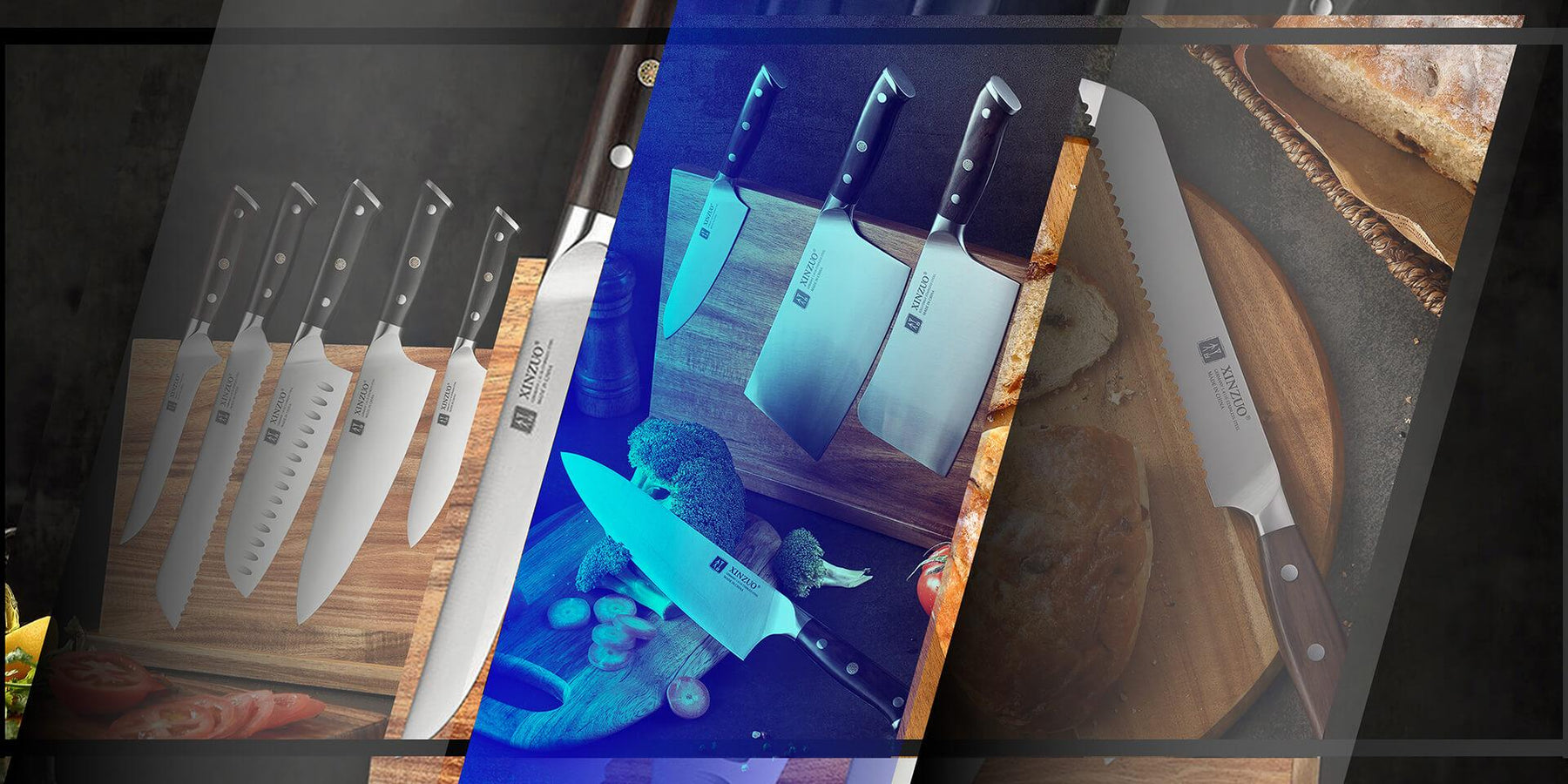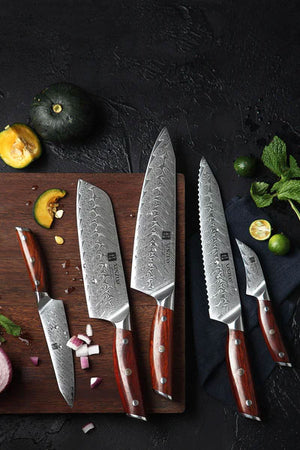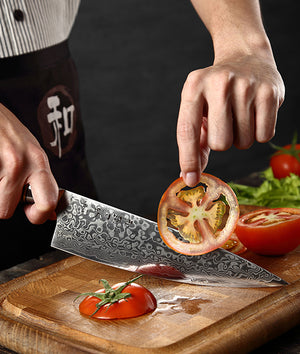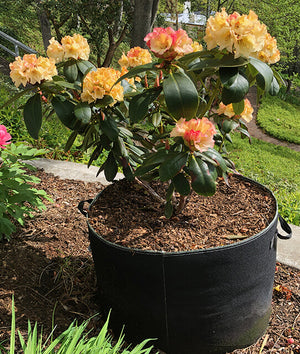
Types of Steel Used in Xinzuo Knives: German 1.4116 Steel
If you’re looking for a material that is ideal for mid-to-high-end kitchen knives, 1.4116 steel – also known as X50CrMoV15 or German steel – is an excellent option. It’s a high-carbon stainless steel that strikes the perfect balance between hardness, resistance to corrosion, and sharpness.
1.4116 German steel, just like all other types of metals, is made up of a complex combination of chemical compounds, including Carbon, of course, Chromium, Molybdenum, and Vanadium, among a variety of other things.
However, it’s not just what is in the steel that makes allows it to have the properties and functionalities that it does. It’s also very much about balancing the amounts of each compound and, arguably most importantly, the techniques that are used to forge the metal.
So, with these things in mind, we’re going to create a guide to din 1.4116 stainless steel so that you can understand its structure, a little bit about how it’s made, its properties, and just what kind of knives this type of steel is ideally used for.
In this article, we’re going to start off by exploring how different types of steel set different Xinzuo knives apart from each other. Then, we’ll move on to the actual chemical composition of 1.4116 steel, followed by the properties of 1.4116 German steel and the best knives this steel is used for.
Let’s dive right in.
How Different Types of Steel Set Different Xinzuo Knives Apart
For those who don’t know too much about different types of steel, what they’re made of, how they’re made, and what their specific properties are, it may be difficult to properly understand exactly how one Xinzuo knife is different to the next. Well, let’s have a quick look exactly why it’s so important to be aware of the type of steel your knife blades are made from so that you can make a well-informed decision.
Now, there are plenty of specific, intricate details that set different types of blades and steels apart, but we’re just going to have a quick look at the main factors. Here are the six most important aspects of knife blades that’ll be influenced by the type of steel they’re made from:
- Sharpness: Different types of steel are able to reach differing levels of sharpness – some can be sharpened to a fairly high degree, while others can go beyond that, making them ideal for precision tasks.
In addition, the actual process of sharpening a blade is easier with some types of metals than others – some can be sharpened using ordinary, general tools, while others require specialized tools and techniques.
- Corrosion Resistance: Corrosion resistance is an incredibly important aspect of knife blades, and some types of steel are more resistant to corrosion than others. That means the former would need a little less care, while the latter will require meticulous cleaning, drying, and more.
- Hardness: Some types of steel have high levels of hardness which tends to lead to better edge retention but also makes blades a little more brittle and vulnerable to chipping. Less hard types of steel are normally a bit more tough and less likely to chip, but they require more regular sharpening.
- Toughness: A blade that’s tough would be ideal for heavy-duty usage, but they can also be a little more fragile in some ways and need to be utilized correctly.
- Edge Retention: Edge retention is all about how long the blade stays sharp. Blades that stay sharp for long tend to be ideal for heavy usage, while those with inferior edge retention require frequent sharpening (although it’s often easier to sharpen these types of knives).
- Aesthetic Appeal: Some types of steel are particularly attractive, like Damascus steel, while others don’t really have anything special to them. This is another major factor that sets different types of steel apart.
It’s pretty clear that the type of steel that’s used to make a knife affects its effectiveness, its functionality, its aesthetic appeal, its longevity, and so much more.
With that, let’s talk about the chemical composition of 1.4116 steel.
The Chemical Composition of German 1.4116 Steel
1.4116 steel is made up of eight main components: Carbon, Chromium, Molybdenum, Vanadium, Manganese, Silicon, Phosphorous, and Sulfur. However, as we mentioned earlier, the mere presence of these compounds isn’t enough in and of itself – it’s about exactly how much of each is involved as well as how the material is forged that makes it what it is.
So, with that in mind, let’s break down the chemical composition of German steel 1.4116:
- Carbon (0.45%-0.55%): This may not seem like a high percentage, but it’s still considered a high-carbon content considering the fact that not a lot of carbon is required to do the trick.
Carbon plays a crucial role in adding hardness and edge retention. By forming carbides with iron and other alloying elements, it not only makes the steel stronger and harder, but it actually enhances the ability of the metal to harden throughout the heat treatment process more generally too.
- Chromium (14-15%): The primary role of Chromium is corrosion resistance, and it does this by forming a passive layer of oxide on the surface of the steel which then prevents rust and oxidation.
Furthermore, Chromium contributes to tensile strength, hardness, and the ability to call the material stainless steel. In order for the steel to be called stainless steel, it must contain a minimum of 10.5% Chromium.
- Molybdenum (0.5%-0.8%): Molybdenum enhances hardness, strength, and resistance to corrosion, as well as contributing to the fine grain structure of the steel. It helps improve the material’s resistance to wear and pitting.
- Vanadium (0.1%-0.2%): By forming hard Vanadium carbides, Vanadium is able to improve hardness and wear resistance, as well as refining the grain structure of the steel, which, overall, enhances toughness and strength. This refined grain structure helps contribute to improved edge retention.
- Manganese (no more than 1%): The role of Manganese is to contribute to hardness, tensile strength, and deoxidization.
- Silicon (no more than 1%): Silicon also plays a role in contributing strength and hardness, as well as an element of deoxidization to improve the quality and consistency of the steel.
- Phosphorus (no more than 0.04%): Phosphorous is great for improving strength and machinability of steel, but too much can result in the steel becoming less tough and more brittle.
- Sulfur (no more than 0.03%): In small amounts, Sulfur is great for improving machinability, but if too much is added, it can make steel brittle and less tough.
Each one of these chemical compounds has an essential role to play in making 1.4116 stainless steel the material that it is, and it’s clear that the amounts that are used need to be exact. Indeed, as we said, it’s not about the compound merely being present – it’s about including a exact amount to ensure that it’s able to perform the task it’s intended for.
Properties of German 1.4116 Stainless Steel
- Tough: 1.4116 steel is known for being tough, due especially to the presence of Chromium and Vanadium. This allows a knife made from 1.4116 German steel to withstand a significant amount of force without fracturing and becoming damaged, making it ideal for heavy-duty tasks.
- Wear Resistant: German 1.4116 stainless steel is generally considered pretty resistant to wear, which means that a knife with a blade made from this material is likely to have a fairly long life. It steel needs to be treated well and with care, but it doesn’t need super close attention. That doesn’t necessarily mean that it boasts edge retention too, however – it’ll still require fairly frequent sharpening.
- Resistant to Corrosion: Similarly, it’s also quite resistant to corrosion, so although you shouldn’t neglect it completely, 1.4116 steel doesn’t require persistent and meticulous cleaning, drying, and storage.
- Sharp: It’s considered pretty easy and effective to sharpen due especially to how hard the metal is. That means that it doesn’t require fancy tools and methods to sharpen a blade made from 1.4116 steel.
- Hard: Although this material certainly does include some compounds that contribute directly to hardness (like Silicon, Vanadium, Manganese, and Carbon, especially), it’s not actually considered a very hard metal. This can be a good thing in that it, in turn, contributes to the fact that it’s more wear resistant and less likely to break.
- Magnetic: 1.4116 stainless steel is magnetic, so if you’re into aesthetics and want to use a magnetic knife block, a blade made from this would be perfect.
Types of Xinzuo Knives That 1.4116 Steel Can Be Used For
Due to their differing properties and subsequent strengths and weaknesses, some types of steel are better used to make some knives over others.
Here are the most highly recommended knives to made from 1.4116 German steel:
- Chef’s Knife
- Filleting Knife
- Carving Knife
- Utility Knife
- Hunting Knife
- Pocket Knife
- Boning Knife
- Cleaver
- Slicing Knife
- Camping Knife
Clearly, this is a pretty versatile type of steel, meaning that if you wanted to, you could make just about any kind of knife from it. And, if you’re aware of its chemical composition the properties of this type of steel, that’ll allow you to make an informed decision when purchasing a knife made from 1.4116 steel.
Final Thoughts on 1.4116 Steel
1.4116 steel, also known as German steel, is a versatile material that can be used to make a plethora of different types of knife blades – it all depends on the functionality you’re looking for.
Shop our Xinzuo 1.4116 Steel knives today.



